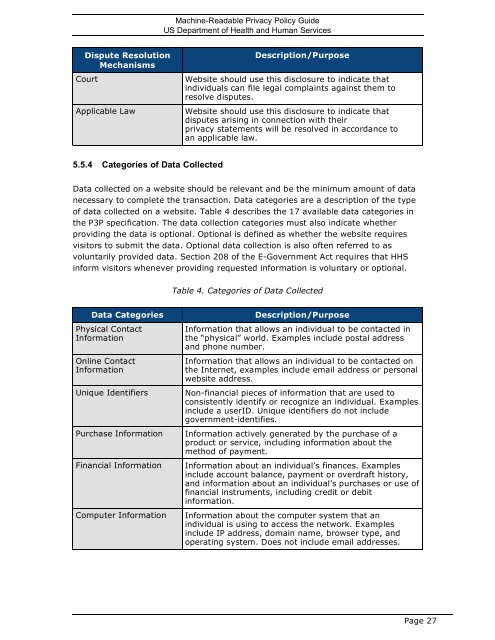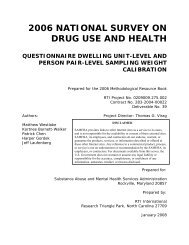HHS Machine-Readable Privacy Policy Guide - Substance Abuse ...
HHS Machine-Readable Privacy Policy Guide - Substance Abuse ...
HHS Machine-Readable Privacy Policy Guide - Substance Abuse ...
You also want an ePaper? Increase the reach of your titles
YUMPU automatically turns print PDFs into web optimized ePapers that Google loves.
<strong>Machine</strong>-<strong>Readable</strong> <strong>Privacy</strong> <strong>Policy</strong> <strong>Guide</strong><br />
US Department of Health and Human Services<br />
Dispute Resolution<br />
Mechanisms<br />
Court<br />
Applicable Law<br />
Description/Purpose<br />
Website should use this disclosure to indicate that<br />
individuals can file legal complaints against them to<br />
resolve disputes.<br />
Website should use this disclosure to indicate that<br />
disputes arising in connection with their<br />
privacy statements will be resolved in accordance to<br />
an applicable law.<br />
5.5.4 Categories of Data Collected<br />
Data collected on a website should be relevant and be the minimum amount of data<br />
necessary to complete the transaction. Data categories are a description of the type<br />
of data collected on a website. Table 4 describes the 17 available data categories in<br />
the P3P specification. The data collection categories must also indicate whether<br />
providing the data is optional. Optional is defined as whether the website requires<br />
visitors to submit the data. Optional data collection is also often referred to as<br />
voluntarily provided data. Section 208 of the E-Government Act requires that <strong>HHS</strong><br />
inform visitors whenever providing requested information is voluntary or optional.<br />
Table 4. Categories of Data Collected<br />
Data Categories<br />
Physical Contact<br />
Information<br />
Online Contact<br />
Information<br />
Unique Identifiers<br />
Purchase Information<br />
Financial Information<br />
Computer Information<br />
Description/Purpose<br />
Information that allows an individual to be contacted in<br />
the “physical” world. Examples include postal address<br />
and phone number.<br />
Information that allows an individual to be contacted on<br />
the Internet, examples include email address or personal<br />
website address.<br />
Non-financial pieces of information that are used to<br />
consistently identify or recognize an individual. Examples<br />
include a userID. Unique identifiers do not include<br />
government-identifies.<br />
Information actively generated by the purchase of a<br />
product or service, including information about the<br />
method of payment.<br />
Information about an individual’s finances. Examples<br />
include account balance, payment or overdraft history,<br />
and information about an individual’s purchases or use of<br />
financial instruments, including credit or debit<br />
information.<br />
Information about the computer system that an<br />
individual is using to access the network. Examples<br />
include IP address, domain name, browser type, and<br />
operating system. Does not include email addresses.<br />
Page 27
















